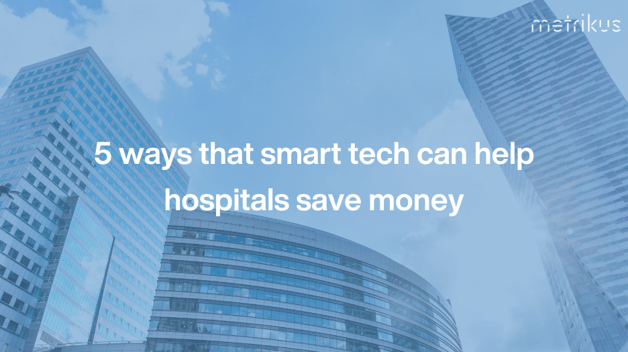5 ways that smart tech can help hospitals save money
Today, many industries are embracing smart tech to maximize their efficiency, and the healthcare sector is no exception.
As well as streamlining processes and optimizing patient care, it’s estimated that the Internet of Medical Things (IoMT) can save the US healthcare industry a massive $300 billion annually.
From resource tracing to Legionella monitoring, this blog post explores five ways that technology can help hospitals save time and money – all while improving outcomes for patients.
1. Fridge and freezer monitoring
To safely store medicines, vaccines and other health products, fridges and freezers need to be kept at specific temperatures – often between 2 and 8°C.
Manual checks not only waste valuable time, but can also be inaccurate if there are temperature fluctuations between checks. And with the US spending around $574 billion on medicines every year, any issues with keeping temperatures at the right level come at a big cost.
With real-time temperature monitoring in fridges and freezers, hospitals can set thresholds and create alerts to make sure an optimal temperature is maintained at all times. This reduces costs by avoiding wastage, increases medicine safety and patient outcomes, and improves energy efficiency by preventing over-cooling.
2. Legionella monitoring
Temperature measurement is key when it comes to reducing Legionella risks, but manual testing only provides a snapshot in time and is prone to human error. Research shows that the potentially fatal bug is present in up to 85% of all hospital water systems and affects over 10,000 Americans each year, so there’s an urgent need to optimize testing.
With sensors in place to monitor water temperature in real time, hospital staff can get automatic alerts for any outlets that are non-compliant and resolve any issues immediately. It’s also a great way to ensure traceability and auditability, as you can access historical data in a central platform at any time.
Companies have been fined over $3 million for failing to monitor water systems properly, so it’s important for hospitals to implement smart solutions now to avoid fines further down the line.
3. Smart cleaning
Cleanliness and hygiene are absolutely critical in hospitals, as the spread of germs can endanger patients who are already at risk. 1 in 31 hospitalized patients have at least one Healthcare-Associated Infections (HAI) at any given time, with more than 680,000 infections and billions of dollars in excess healthcare costs related to HAIs across the US every year.
Smart sensors can be installed to track cleaning frequencies and alert staff when a space is unclean. It’s easy to identify areas that are used most frequently and at what specific times, creating a much more effective cleaning regime. All of this means that spaces are kept safe for patients, staff and visitors alike.
.png?width=806&height=451&name=_5%20ways%20that%20smart%20tech%20can%20help%20hospitals%20save%20money%20(3).png)
4. Occupancy monitoring
Hospitals can quickly become overcrowded with patients, and this can cause a host of potentially life-threatening issues, including resource shortages and the transmission of infectious diseases. A study on a county hospital in New York found that it could actually save $9.8 million a year by avoiding overcrowding in its Emergency Department (ED).
By displaying real-time occupancy data, an IoT platform allows staff to understand and control how a healthcare facility is being used. It’s easy to see how many people are on each floor or in certain areas, and even which beds are currently free. This can be used to direct patients to underutilized floors or empty beds quickly and efficiently.
Occupancy patterns that emerge over time can give a real insight into usage trends across a facility, helping to improve operational efficiency throughout hospitals.
5. Indoor air quality monitoring
50% of all illnesses are either caused or exacerbated by polluted air, so improving indoor air quality in hospitals is a top priority.
By installing indoor air quality sensors, hospitals can monitor key factors in real time, including temperature, humidity, carbon dioxide (CO2), total volatile organic compounds (TVOCs) and particulate matter (PM2.5). And more importantly, a software platform can show what these values should be, and how the current values could be impacting patients.
Smart alerts can notify key members of staff when air quality parameters deviate from their optimal zone, so that steps can be taken to rectify any issues – ensuring the safety and health of staff and patients alike.
Indoor air quality monitoring can also help to identify inefficiencies in HVAC systems, leading to energy savings of up to 20%. And with hospitals spending more than $8 billion on energy every year, this could equate to some big cost savings!
What are you waiting for?
With the right technologies in place, hospitals can streamline processes, optimize patient care and save all-important time and money.
If you’d like to find out more, get in touch with us today.




